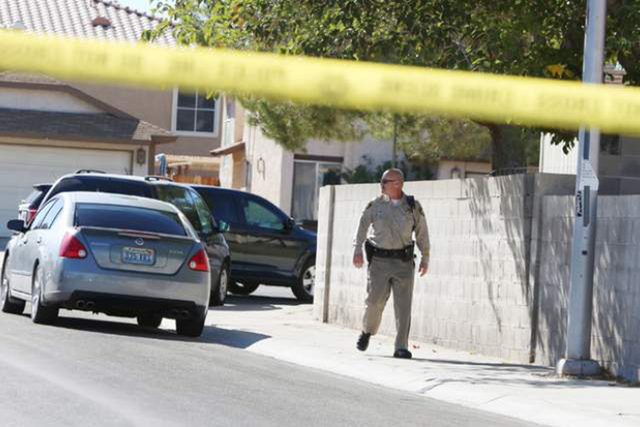Uptick in slayings has Metro seeking community help
When Las Vegas police found 62-year-old Michael O’Brien lying dead from a gunshot wound in a cul-de-sac in the northwest valley Thursday, it was clear that homicides were back on the rise.
O’Brien was killed just as parents were shuffling their kids to nearby Tobler Elementary School. His slaying, the 107th in Metro’s jurisdiction this year, marked an unwanted milestone: With two months left in 2014, the agency already has investigated more than last year’s total number of homicides.
Nationally, homicides and all violent crimes have been on the decline for about two decades, according to statistics kept by the FBI.
Metro’s statistics had been following suit, seeing a steady decrease through 2012. That year, the department investigated just 84 homicides.
In 2013, that number spiked to 106. And the increase has continued.
Police still aren’t sure what has caused the rise in homicides and other violent crime, but they know they have to curb the trend somehow.
Metro’s homicide unit is good at making arrests in murder cases. Detectives typically see a suspect arrested in 75 percent of the cases they investigate, which then are sent on to the court system. Nationally, the so-called “clearance rate” hovers around 60 percent.
But Metro sees its job not as just closing out homicide cases but trying to prevent them from happening.
And to do that, they need help.
Last month, Metro brought dozens of local community and business leaders together for a daylong discussion in hopes of both raising awareness and coming up with a plan on how the community can help police better prevent murders.
A handful of common themes prevailed throughout the discussions: Police and other outreach programs need to communicate better about potential victims, reach children at an early age and teach them how to solve their problems without violence, and promote more community involvement in high-violence areas.
“We’re only as strong as the community that supports,” Metro homicide Capt. Csaba Maczala said at the event. “The communication process has to be improved.”
Departing Sheriff Doug Gillespie said preventing homicides is a “daunting task” that must be attacked. Metro’s long-term strategies must be improved.
“They have not been very successful in long-term prevention of homicides,” Gillespie said.
Using homicides as a measuring stick for the state of violence can be misleading because they make up a small percentage of total violent crimes, said Tod Burke, a former Maryland police officer and current criminal justice professor at Radford University in Virginia.
Looking at all violent crime statistics — including murders, forcible rapes, robberies and aggravated assaults — can paint a more realistic picture, Burke said. These crimes give insight into the increasingly violent culture of an area.
Like homicides, violent crime in general has fallen nationally over the years, seeing a roughly 12 percent drop since 2004.
In that same time period, Metro’s violent crime has gone from 9,784 incidents in 2004 to 11,382 in 2013 — about a 16 percent jump.
Still, experts say preventing individual homicides can be difficult compared with other crimes.
Take O’Brien’s death. Police said he was involved in a fight with another man shortly before he was shot. Fights are tough to predict but are the leading cause of homicides in Las Vegas, according to police, followed by domestic violence and drug-related killings.
“They’re a crime of passion, a heat-of-the-moment-type thing,” Burke said.
Police have made no arrests or identified any suspects in the O’Brien case.
Another man was found shot to death early Saturday morning in the 1300 block of Hassell Avenue, near Martin Luther King and Lake Mead boulevards. That slaying brought the departments total number of homicides to 108.
Stopping such crimes can be complicated, Burke added, but he lauded Metro’s recent efforts of getting help from people outside the police force. He thinks they are on the right track.
“This is a community issue,” Burke said. “I really like the idea of getting community input and getting as many people as possible involved in crime prevention.”

















